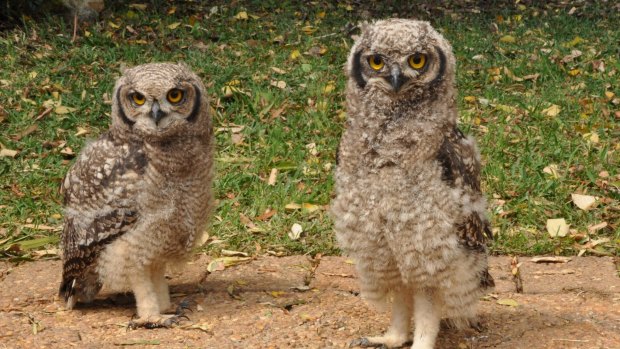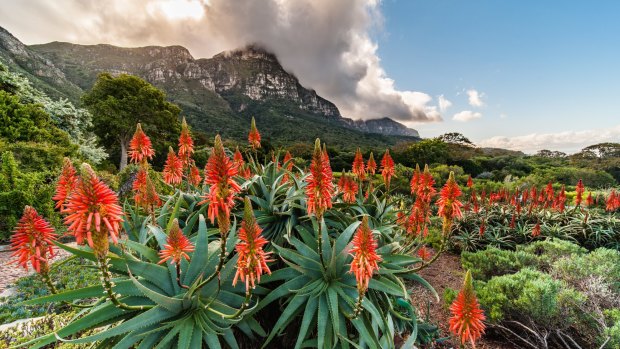This was published 5 years ago
Cape Town's Kirstenbosch: This could be the world's best botanical garden
By Alison Stewart

Spotted Eagle Owl chicks.Credit: ALICE NOTTEN/SANBI
Sprawled across Table Mountain's eastern slopes with Skeleton Gorge, Castle Rock and Nursery Ravine towering over it is arguably the world's finest botanical garden – Kirstenbosch - a plant lovers' Disneyland.
Cape Town's greatest unheralded tourist attraction is a living place of mountains and plants and wind and aromas that sits at the very epicentre Cape Town's spiritual heart, only 13 kilometres from the city centre.
The world boasts many exquisite botanical gardens - Canada's Butchart Gardens on Vancouver Island, London's Kew Gardens, Singapore's Gardens by the Bay, Rio's Jardim Botanico, our own Sydney or Melbourne Royal Botanic Gardens, to name a few. Picking the best is subjective.

Beautiful flowering aloes in the Kirstenbosch Gardens.Credit: Julian Parsons
All good gardens at the very least must inspire joy, stir the spirit and soothe the mind. Exceptional gardens often include a significant setting, diverse biomes, historic links and conservation/preservation initiatives.
The visceral allure of a botanic garden might have something to do with its relationship to our life journey. In a plant's growth cycle, we observe vigour, beauty, productivity, decline, and then rebirth.
In the words of English author Rumer Godden, "a garden isn't meant to be useful. It's for joy," and the most joyful in my opinion, is Kirstenbosch. True, there's bias. I grew up nearby, its flora, topography and aspect constant in my young world. My parents' ashes are scattered there.
Kirstenbosch, however, speaks for itself. It's not merely the judiciously sited flowerbeds, the trees, ponds and lawns. Here are some of its attributes.
CAPE FLORAL KINGDOM
Kirstenbosch showcases a huge diversity of flora thanks to its position within the Cape Floral Kingdom. This World Heritage-listed kingdom near South Africa's southern tip is the smallest of the world's six kingdoms and, with its extraordinarily high diversity of distinctive flora, arguably the richest.
Kirstenbosch covers 528 hectares - 36 hectares are cultivated, the rest is natural forest and a concentration of the wider Cape Floral Kingdom's famous fynbos (fine bush) – best enjoyed from August to November.
More than 7000 of Southern Africa's 22,000 plants species are grown here including fynbos - predominantly proteas, heaths and ericas. The broader 90,000-square-kilometre Cape Floral Kingdom (the only kingdom that falls entirely within one country) has more than 9000 known species of flowering fynbos, 70 per cent of which can only be found in this region.
Kirstenbosch's diversity blows your mind.
HISTORY
The gardens offer a microcosm of Cape history, told through flora. There's a remnant of the thorny wild almond hedge (a member of the protea family) that Dutch East India Company administrator Jan van Riebeeck planted in 1660. Van Riebeeck set up a Cape refreshment station for ships to the East Indies but the new settlement crossed traditional Khoikhoi grazing routes. Conflict broke out in 1659, and the defensive boundary hedge marked the start of South Africa's long history of disputed land battles, culminating in apartheid.
Trek up the hill and this hedge that was there at the beginning of white settlement remains there today. Continue to the mountain contour path to gaze across the valley that melts into the Cape Flats and eventually bumps against the pale blue fringe of the Hottentots Holland Mountains.
Various people owned the land after the Dutch East Indies Company lost control of the Cape in 1795 to new occupiers, the British. One of them, Colonel Christopher Bird, discovered a clear water spring around which he built a bird-shaped pool. This is confusingly known as both Colonel Bird's bath and Lady Anne Barnard's bath – she had a significant impact on late 18th-century Cape cultural life. Do walk to this cool "bath" in the Dell, just below the ancient cycad garden.
In 1902, Cecil John Rhodes bequeathed Kirstenbosch to the nation and in 1913 it became the National Botanic Garden. Director Henry Pearson enlisted South Africans in plant collections that exist to this day. In went the avenue of pink-canopied Cape chestnuts, the beds of vygies or mesembryanthemums and other succulents near the entrance. The aloe koppie (little hill) was planted and a pelargonium collection.
Professor Pearson is buried on the slopes overlooking the cycads and the Dell. A blue Atlas cedar marks his grave. The inscription says: If ye seek his monument, look around. A self-guided heritage trail traces the history of Kirstenbosch, which intersects that of the Cape.
TABLE MOUNTAIN
Kirstenbosch is a dramatic overture to the vivid opera that is Table Mountain – arguably an unparalleled setting. The gardens are part of the mountain, which Nelson Mandela (whose sculpture is near the main entrance) named "a sacred and precious place, a gift to the earth."
From its Rhodes Drive Gate 1 entry (there are three gates), Kirstenbosch slopes up through the historic 1898 camphor avenue, ponds, lakes, lawns, diverse plant and flower gardens, arboretum and three types of fynbos dependant on altitude, to meet the mountain contour path at about 400 metres.
You can hike to the top of the mountain – I recommend Smuts Track up Skeleton Gorge. It's a Tolkien fantasy of seeping sandstone and granite, pristine indigenous Afromontane forest of assegaai trees, rooiels, ironwoods, and keurbooms and trickling streams. Allow about four hours. Fitness is required - there are ropes and ladders.
Once at the top, it's a two-hour hike across the table to descend via the cable car. Take food, water (don't drink the mountain water), sunscreen, hat, raincoat, and hiking boots. Nursery Ravine also offers a steep climb up to Hutchinson Dam.
A LIVING MUSEUM
Kirstenbosch is a magical world of different gardens. There's a garden of extinction displaying some of the nearly 1500 South African endangered plants, an elevated fragrance garden, a short, circular braille trail, a "useful plants" garden devoted to traditional medicinal and practical plants.
Look out for the garden of weeds – indigenous plants that are weeds elsewhere - The Koppie and pelargonium garden, peninsula and vlei gardens, water-wise garden, Mathews rockery displaying succulents and bulbs, gardens dedicated to ericas, proteas, restios, buchus, vygies (a colour explosion between September and October) and the Dell, the oldest part of the garden replete with tree ferns and shade plants.
The conservatory with its central baobab has sections representing arid ecological regions. Look out for the welwitschias and stone plants. The arboretum has more than 450 southern African tree species. The sculpture garden features works in the Shona tradition.
Unmissable is the cycad amphitheatre with its valuable, rare, Jurassic Era "living fossils" that remain relatively unchanged for 200 million years. Children will enjoy the lurking, anatomically correct dinosaurs.
Finally, the 130-metre centenary tree canopy walkway, known as the "Boomslang" for its snake-like appearance, winds through and over the Arboretum trees, giving stunning views of the mountain, gardens and Cape Flats.
ANIMALS
Kirstenbosch has more than 125 bird species including the long-tailed sugarbird and colourful sunbird, spotted eagle owls, a veritable plague of guinea fowl, grysbok, caracal, spotted genet, Cape porcupine, angulate tortoises, marsh terrapins and water mongoose.
RELAX
Picnics are popular, especially around the duck pond or on the rolling lawns. Take your own or buy hampers/takeaway from the Kirstenbosch Tea Room or Moyo restaurant. The Tea Room at Gate 2 is an institution and recommended. Summer Sunset Concerts are packed every Sunday.
TRIP NOTES
VISIT
Open daily from 8am to 7pm in summer (September-March) and 8am to 6pm in winter (April-August). Adult entry about $7. The City Sightseeing hop-on, hop-off bus (mini peninsula tour) stops at the garden 15 times daily in summer. Free 90-minute guided walking tours run from the Visitor's Centre. Seven-person shuttle car tours cost about $8. See sanbi.org/gardens/kirstenbosch
FLY
Qantas flies daily from Sydney to Johannesburg. Various airlines fly regularly to Cape Town. See qantas.com
Sign up for the Traveller Deals newsletter
Get exclusive travel deals delivered straight to your inbox. Sign up now.